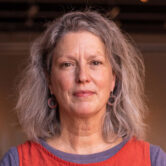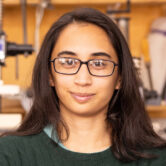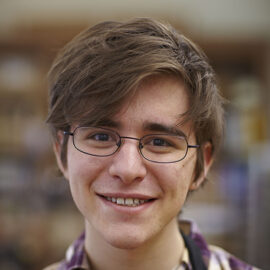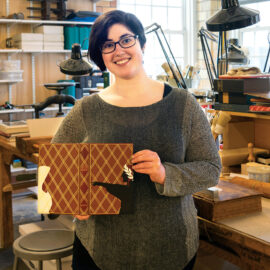Bookbinding
The two-year, comprehensive Bookbinding program teaches students how to make, restore, and preserve books and other printed treasures.
During the first year, you’ll learn the history and development of this traditional craft, as well as develop a host of necessary skills. You’ll make a variety of historical and modern binding structures, boxes, and other protective enclosures. The repair of cloth and paper bindings will supplement your understanding of the way books function and break down.
Toward the end of the first year and throughout the second year you will create and repair leather bindings. During your second year, you’ll have the opportunity to choose additional projects that reflect your personal career goals in conservation, fine binding, or other areas of the field. Additional learning takes place outside of the classroom—through exhibits, conferences, and field trips to binderies, historic collections, private studios, and conservation labs.
Schedule & Curriculum
We accept qualified applicants throughout the year. The program is extremely competitive and fills quickly, so you should apply as early as possible.
- Students are admitted in September.
- The maximum enrollment is 16 students.
- Class meets 8:00 am – 3:00 pm, Monday – Friday, September through May.
- The program length is two, nine-month academic years (72 weeks or 2340 class hours*).
- Students who complete the program receive a Diploma of Bookbinding.
* Class hours equals clock hours.
Careers
During your studies, you’ll photograph your work and create a portfolio. Your portfolio, along with connections you’ll make during field trips and through Student Services, will help you find employment opportunities once you’ve graduated. Our Bookbinding graduates work in a wide variety of careers in binderies and conservation labs.
Our graduates work in reputable institutions such as:
- Universities such as Harvard, Columbia, Michigan State, Indiana University, Duke, Texas A&M, UCLA, and UC Berkeley
- US National Archives and Records Administration
- Federal Emergency Management Agency
- Boston Athenaeum
- National Park Service
- Museum of Fine Arts, Boston
- Boston Public Library
- Huntington Library
- Rare Book School
- Winterthur / University of Delaware
Some roles in which are graduates work include:
- Bindery owners
- Book conservators
- Bookbinders for private clients
- Paper conservators
- End processors
- Conservation technicians
- Project conservators
- University faculty; Book Conservation
Below, you’ll find general information on bookbinders and conservators. Please note that our job classifications are not an exact match to those defined by the U.S. Department of Labor (DOL). Therefore, job prospects, wages, and salaries may differ.
There are two DOL job classifications which describe the work that bookbinding graduates do: Bookbinders and Conservators. According to the DOL, Bookbinders use a wide range of skills, some of which are performed mechanically. Hand skills are recognized by the DOL as well:
“A small number of bookbinders work in hand binderies. These highly skilled workers design original or special bindings for limited editions, or restore and rebind rare books. Some binders repair books and provide other specialized binding services to libraries.”
The DOL classifies Conservators this way:
“Conservators manage, care for, preserve, treat, and document works of art, artifacts, and specimens—work that may require substantial historical, scientific, and archaeological research. They use x rays, chemical testing, microscopes, special lights, and other laboratory equipment and techniques to examine objects and determine their condition and the appropriate method for preserving them. Conservators document their findings and treat items to minimize their deterioration or to restore them to their original state. Conservators usually specialize in a particular material or group of objects, such as documents and books, paintings, decorative arts, textiles, metals, or architectural material.”
There are many factors that determine salary and wages, including:
- Education
- Training
- Years and type of experience
- Economic conditions
- Location
- Employee type
This information from the Department of Labor (DOL) shows the outlook for Bookbinders and Museum Technicians and Conservators as of May 2023:
- Bookbinders: Annual salary average: $40,860 | Hourly wage average: $19.64
- Museum Technicians and Conservators: Annual salary average: $54,890 | Hourly wage average: $26.39
- Within that group of Museum Technicians and Conservators:
- College or university workers: Annual salary average: $60,930 | Hourly wage average: $29.29
- Museums, Historical Sites, and Similar Institutions: Annual salary average: $52,210 | Hourly wage average: $25.10
The following information is from the US Department of Labor, Occupational Employment and Wages, May 2024, Bookbinders and Museum Technicians and Conservators:
- Bookbinders held about 35,800 jobs in 2024, Museum Technicians and Conservators held about 15,700.
- The number of job openings for Bookbinders is expected to be 30,000 during the 2025-35 decade, and 16,500 for Museum Technicians and Conservators. Note these numbers do not include self-employed binders.
People
Faculty



Meet Our Alumni

Samuel Feinstein BB ’12“As far as I know, the U.S. does not have any bookbinding programs like NBSS… a multiple-year program, bench-oriented, and focused on craft.”

Natalie Naor BB ’17“So much time at the bench allowed me to really work through what we learned from our instructor and the conventions of my craft, make the mistakes I needed to make and learn from, and experiment.”
Explore the Facilities
Students get dedicated bench space during the two-year program. You’ll be responsible for getting hand tools and a few basic textbooks, but our Bookbinding facilities have all the equipment you need for your studies.
Our Bookbinding facilities include two board shears, two combination presses, a job backer, a Kwikprint stamping machine with several type fonts, 10 presses, finishing tools, a photo copy stand, a guillotine, and an extensive library of bookbinding texts.
Additional Information
- Bookbinding program brochure: Download at-a-glance details.
- Admissions Info: How to get your application started and what you need to apply.
- Financial Aid: We’re dedicated to helping you afford the cost of your education. Learn about our financial aid options.
2023 Bookbinding Graduate & Employment Report
- 6 Bookbinding students started the program in September 2020 and had an intended graduation date of June 2022.
- 83% of this student cohort graduated in 2022.
- 60% of these graduates are employed in the field.
- This data was officially reported to ACCSC in October 2023.
2024 Bookbinding Graduate & Employment Report
- 8 Bookbinding students started the program in September 2021 and had an intended graduation date of June 2023.
- 75% of this student cohort graduated in 2023.
- 83% of these graduates are employed in the field.
- This data was officially reported to ACCSC in October 2024.
2025 Bookbinding Graduate & Employment Report
- 8 Bookbinding students started the program in September 2022 and had an intended graduation date of June 2024.
- 100% of this student cohort graduated in 2024.
- 50% of these graduates are employed in the field.
- This data was officially reported to ACCSC in October 2025.
This disclosure is required by our accreditors, the Accrediting Commission of Career Schools & Colleges (ACCSC).
For each of our career training programs, we consult with a group of top professionals in the field to ensure our curriculum continues to meet industry needs and trends.
The Bookbinding Program Advisors are:
- Mary Patrick Bogan
- Rebecca (Bexx) Caswell BB ’09
- Samuel Ellenport
- Erin Fletcher BB ’12
- Babette Gehnrich
- Saira Haqqi
- Paul Parisi
- Graham Patten
- Todd Pattison
- James Reid-Cunningham BB ’90
Questions?
Contact Rob O’Dwyer, Director of Admissions, at 617-227-0155 x111 or admissions@nbss.edu.